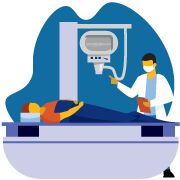
Exposure to radiation
Ionizing (x-rays, radionuclides) and non-ionizing radiation (UV, lasers) exposure may occur in health-care settings and pose specific risk to the health and safety of health workers.
Exposure to radiation

Preventive measures (2-4)
Use radiation only to cases where the benefits outweigh the risks
Put in place shielding, protective barriers, safety interlocks, warning signs and signals
Obtain permission from the relevant authority for medical use of radiation and follow the recommendations for safe use
Restrict access to areas where radiation is used to authorised persons only
Train workers on safe use of equipment and sources of radiation
Organize regular inspection of medical radiation devices by the competent authority
Determine the level of exposure of different occupational groups for planned exposure
Monitor exposure and organize medical surveillance of exposed workers
Encourage female workers to report if they become pregnant and reallocate them to tasks without radiation exposure
Develop standard operating procedures for action in case of accidental exposure to radiation
Report all accidental and planned exposures above the exposure limit
Report cases of occupational injuries and diseases due to radiation exposure to national authorities responsible for compensation
Provide workers with adequate personal protective equipment including protective clothing, respiratory protective equipment, protective aprons, gloves and organ shields
Follow the measures recommended by the manufactures for use of medical devices with non-ionizing radiation, such as UV (phototherapy and germicidal lamps) and lasers
Use eye and skin protection and proper clothing while working outdoors with high levels of UV index from solar radiation
References
(1) Laser safety: Risks, hazards, and control measures.
Smalley PJ. Laser Ther. 2011; 20(2): 95–106.
(2) Radiation Protection and Safety of Radiation Sources: International Basic Safety Standards.
International Atomic Energy Agency. 2014.
(3) Occupational Radiation Protection.
International Atomic Energy Agency. 2018.
(4) Radiation Protection and Safety in Medical Uses of Ionizing Radiation.
International Atomic Energy Agency. 2018.

